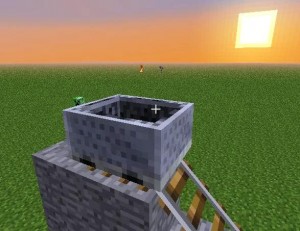 The topic for my third meeting with the Sammy Y group was measuring the speed of minecarts. While for the genetics of sheep session I overestimated the knowledge of my audience, this time I underestimated. The night before, I reminded myself how redstone worked and created a couple of starting gates and such. When I asked the kids if they knew how to use redstone, they erupted with knowledge and described some of their builds. In fact, they had already began laying down rail and running a continuous cart around the base of our location beacon. They certainly knew more than I did. A tinge of concern gurgled in my stomach as they took off laying down power rail before I could even pose the question we were to investigate.
The topic for my third meeting with the Sammy Y group was measuring the speed of minecarts. While for the genetics of sheep session I overestimated the knowledge of my audience, this time I underestimated. The night before, I reminded myself how redstone worked and created a couple of starting gates and such. When I asked the kids if they knew how to use redstone, they erupted with knowledge and described some of their builds. In fact, they had already began laying down rail and running a continuous cart around the base of our location beacon. They certainly knew more than I did. A tinge of concern gurgled in my stomach as they took off laying down power rail before I could even pose the question we were to investigate.
Please forgive the digression from Minecraft while I write about teaching in general. I believe many teachers fail to provide authentic learning to their students because of their belief that they should always know more than the students. Teachers are often fearful of their students knowing more than they do about a topic. Embracing what students know relieves teachers of this pressure and allows teachers to capitalize on a student’s knowledge or expertise in order to take the student’s learning to the next level. Moreover, students love teaching the teacher, and adults for that matter, (see Kids Teaching Adults Minecraft), and ironically, this makes teaching the real students easier. End of digression.
Originally I was hoping to see if we could investigate whether the angle of the track affected the speed at which minecart moved, but I quickly realized that the track can only be put down at a 45 degree angle. So I just posed the general question to the kids “how fast can minecarts go in Minecraft?” The students quickly began designing their experiments. Two different designs emerged, flat tracks and 45 degree angle tracks.
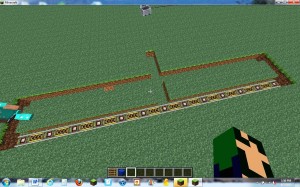
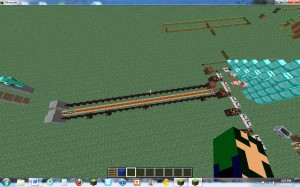
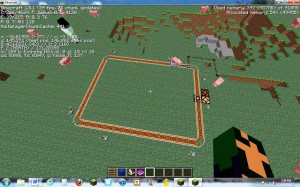
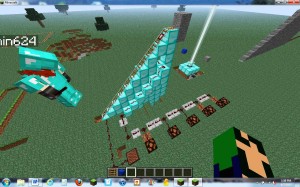
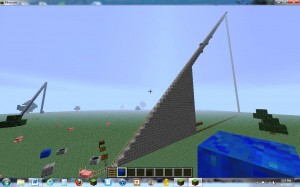 I knew the true length of the downhill tracks was not simply the number of blocks but I was not about to go into into hypotenuses. Although this idea would provide context to create meaning in a good geometry and/or trigonometry lesson for middle or high school students. In fact, given more time, it might be interesting to try with to teach this to elementary school kids. I have a feeling given the context, it might work.
I knew the true length of the downhill tracks was not simply the number of blocks but I was not about to go into into hypotenuses. Although this idea would provide context to create meaning in a good geometry and/or trigonometry lesson for middle or high school students. In fact, given more time, it might be interesting to try with to teach this to elementary school kids. I have a feeling given the context, it might work.
The kids began timing their carts, “1-1000, 2-1000. It takes 2 seconds.” I gently suggested that it would be good to use a timer on a phone and also to have some type of gate that you could visually see when the cart had arrived at the end of the track. This experiment was a great opportunity to discuss units of measurements. We discussed the meaning of miles per hour and that this was a measurement of how far something has traveled in a given amount of time. What should the unit of measurement be in Minecraft? “Blocks per hour!” “Blocks per minute!” They shouted. I pointed out that their track would have to be very long to measure in those units and so they quickly realized that they should measure in blocks per second.
Again the idea of completing more than one trial of the experiment to come up with an average. The students measured the time it took for the carts to move a certain number of blocks and then they determined the speed. I asked the kids to record or report their data in a data table. Below are some of the tables that they produced. Some kids put their data in books and gave them to me in game. They hovered around me, in game, as I read their data and waited for me to return their book to them, not unlike returning papers in the classroom. Kinda cool.
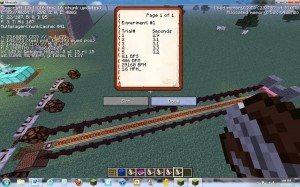 Their data tables presented the opportunity to discuss what I call “naked numbers,” that is, measurements or data without units. In addition, I had a conversation with one student about the difference in meaning between the units of seconds per block and blocks per second. Another student took to collecting all the data and organizing it in one big table. This boy’s predilection for organizing data came shining through.
Their data tables presented the opportunity to discuss what I call “naked numbers,” that is, measurements or data without units. In addition, I had a conversation with one student about the difference in meaning between the units of seconds per block and blocks per second. Another student took to collecting all the data and organizing it in one big table. This boy’s predilection for organizing data came shining through.
As I left the group this time, Sammy Y’s son was wondering if a person or pig being in the minecart would affect the speed. Great question! We talked a bit and then he described how he could make two starting gates using redstone to release both at the same time and if the track was long enough we could simply see one moving faster than the other.
Science and math through Minecraft! Three very different lessons: investigating whether air exists in Minecraft, the genetics of sheep and the speed of minecarts. According to Sammy Y these sessions are providing “food for thought for the whole family” and having a “real impact in [the kids’] thinking about science and MC for sure!”
These topics definitely could be investigated more rigorously and provide authentic learning for more advanced students. Not sure what the next topic will be, but I will keep you posted. (Ha! Pun intended.)
As always, thank you for reading.

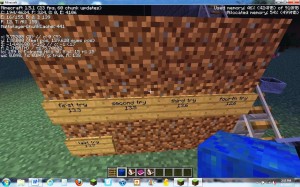
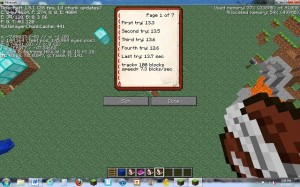
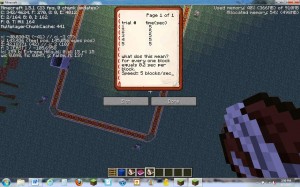
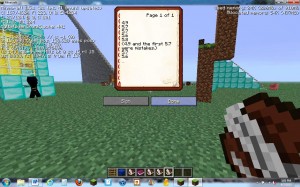

Pingback: Mr G's Idle Musings » Blog Archive » My Diigo 05/13/2013